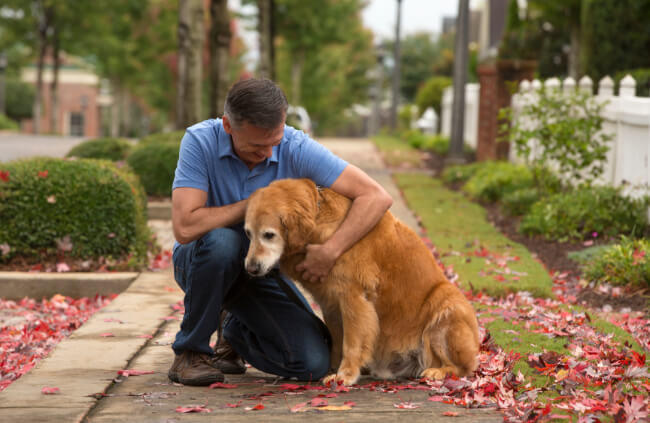Owning a dog is a lifetime commitment, but mainly one for the lifetime of the dog – humans live many decades longer than dogs, whether you have a toy breed or a working dog.
Regardless of your dog’s breed or personality, they eventually come to a point where they will have to say goodbye. Making the decision to euthanize a family dog is one of the most difficult choices a pet owner can face.
Dog euthanasia is a deeply personal, emotionally taxing experience that requires a great deal of empathy, understanding, and support. Pet owners who may be faced with this heartbreaking decision will benefit from learning about the process and how to get through it.
More...
Understanding Dog Euthanasia

Euthanasia, also referred to as 'putting a pet to sleep', involves administering a lethal injection that gently and peacefully ends a dog's life. It is often a choice made by pet owners when their dog's quality of life has deteriorated due to severe illness, age, or untreatable health conditions.
Veterinarians are trained to perform this procedure in the most humane, painless, and respectful manner possible.
Assessing Quality of Life
Before deciding on dog euthanasia, it's crucial to evaluate your pet's quality of life. Here, the key factors to consider include the dog's ability to eat, drink, and maintain bodily functions, manage pain, and engage in normal behaviours.
The HHHHHMM Scale, or H5M2 Scale, an acronym standing for Hurt, Hunger, Hydration, Hygiene, Happiness, Mobility, and More Good Days Than Bad, can be a helpful tool in making this assessment. For each category, you can assign a score from 0 to 10, with 10 being the best possible score.
Generally, a total score of 35 or above suggests a satisfactory quality of life. However, it's essential to consult with your vet and consider the holistic picture, as the scale is a guideline rather than an absolute rule.
Discussing Options with Your Vet
Open, honest communication with your vet is key during this process. Your vet can provide an informed medical opinion, giving you insight into your pet's current condition, the likelihood of improvement, the possible options for palliative care, and whether euthanasia might be the most humane choice.
Facing Emotions When Considering Euthanasia
It's normal to experience a range of emotions, such as denial, guilt, sorrow, and even anger, when considering euthanasia for your pet. It's crucial to remember that dog euthanasia is often the final act of love and care that we can offer our pets, relieving them from suffering.
Reach out to your support network, consider speaking with a pet loss counsellor or joining a pet loss support group to help navigate these difficult emotions.

The Dog Euthanasia Process
If the decision for euthanasia is made, it's essential to understand the process. Typically, it involves two injections.
- The first is a sedative to relieve anxiety and discomfort, helping your dog drift into a deep, peaceful sleep.
- The second injection is an overdose of anaesthesia that gently and painlessly stops the heart.
You have a choice about whether you'd like to be present during the procedure. Some people find comfort in being there, offering their dog a familiar presence and comfort during their final moments.
If the prospect is too overwhelming, it's perfectly okay to say goodbye to your dog beforehand. But many veterinarians would advise that you be there for your dog as they take their last breaths, as they often look for their owners before the end.
Some veterinarians can also arrange to come to your home to perform the procedure – this is generally the best option since your dog will be in a place where they know they are safe and loved.
Speak to your trusted veterinarian about your options, as many are willing to make the trip for owners and dogs that they’ve known for a long time.
Post-Euthanasia Decisions
After euthanasia, there are several options for your pet's remains, including burial, cremation, or leaving the body with your veterinary practice. It's okay to take some time to decide what feels right for you. Remember, there is no 'right' or 'wrong' choice here; it's about what brings you the most comfort and peace.
Grieving and Moving Forward
Grieving is a personal process that has no specific timeline or 'right' way. Allow yourself to grieve, feel the emotions, and remember the joy your pet brought to your life. Consider creating a memory box with photos, toys, or a lock of hair to remember your pet.
Engaging the help of an understanding pet photographer can help you create everlasting memories with printed and framed artwork for your home.
When you're ready, memorialising your pet in a meaningful way, such as planting a tree in their memory or donating to an animal charity in their name, can help with healing.
Conclusion
Owning a dog, whether it is an affectionate Golden Retriever or a sweet little Dachshund, is an amazing and fulfilling experience. Euthanizing a beloved pet is a challenging decision that no pet owner wants to face. But when the time comes, it is an act of kindness that can alleviate suffering and provide a peaceful passing for our cherished companions.
Remember, it's okay to seek support and take time to grieve, and most importantly, cherish the memories of the love and companionship you shared with your pet. It's possible to navigate this painful journey and eventually find peace in knowing that we did our best for our loyal friends.
